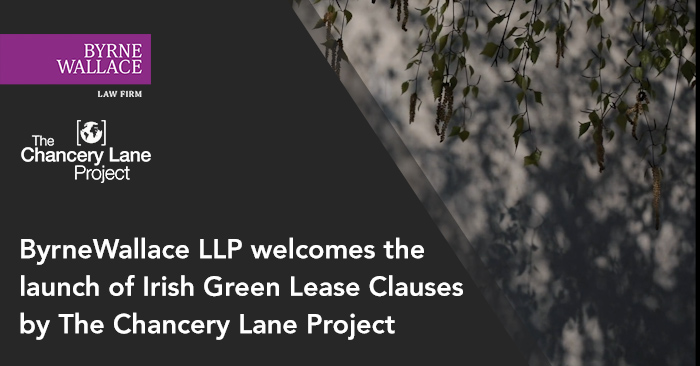Irish Green Lease Clauses: Emily and Tom’s Clause
Tuesday, 14 February 2023
Continuing our series on Irish green lease clauses, this week we focus on repair and alteration covenants, rent review assumptions and covenants for the protection of energy and sustainability ratings, together known as Emily and Tom’s Clause.
The Chancery Lane Project (“TCLP”) has launched a suite of Irish green lease clauses for use in commercial leases in Ireland. ByrneWallace LLP, together with Arthur Cox LLP and Mason Hayes & Curran LLP, spearheaded the development of this suite of green lease clauses by the Irish Property Working Group of TCLP.
The suite of clauses is divided into three sets, named after children to recognise that our actions to combat the climate crisis will benefit future generations.
Emily and Tom’s Clause includes:
- sustainable and circular economy provisions in the repair, alteration, yielding up and decoration covenants in a lease, which require tenants to prioritise the use of re-used, reclaimed, sustainable, recycled or recyclable products or materials;
- restrictions on a tenant carrying out alterations to the demised premises that might adversely affect any green building certification or the BER or that might be contrary to efficiency objectives or objectives set out in an environmental performance plan;
- provisions allowing a tenant (subject to landlord’s consent) to carry out alterations to the demised premises which improve the certification, environmental performance etc of the demised premises;
- clauses requiring a tenant to yield up the demised premises at the end of the lease having complied with its green obligations under the lease;
- alternative yield up clauses that provide for a mechanism by which a tenant may not be required (subject to certain conditions) to reinstate any alterations which improve the environmental performance or where such reinstatement would adversely affect certification, BER etc.;
- tenant’s compliance covenants to protect sustainability or any green building certification rating and/or BER; and
- an additional assumption upon a rent review relating to the certification and/or BER of the demised premises.
The clauses are drafted primarily for use in leases of new office premises in a multi-let building where the tenants contribute to the maintenance of the building common areas via a service charge regime. Some of the clauses may be suitable for use in leases of other types of premises. The clauses should be treated as a menu from which landlords and tenants, working with their solicitors and other professional advisors, can select and tailor clauses that are suitable for their premises and their sustainability goals.
Environmental laws and practices are constantly changing as governments, businesses, NGOs and individuals seek to find solutions to climate change. These clauses are likely to evolve and change over time to reflect changes in law and practice.
See our previous article for information on Odhran’s Clause. Next week we will discuss Amélie and Lauri’s Clause.
The ByrneWallace LLP Property/Real Estate team advises both landlords and tenants on drafting and negotiating green lease clauses. If you would like further information on green lease clauses, please contact Alison O’Sullivan, Michael Walsh or your usual contact on the ByrneWallace LLP Property/Real Estate team.

